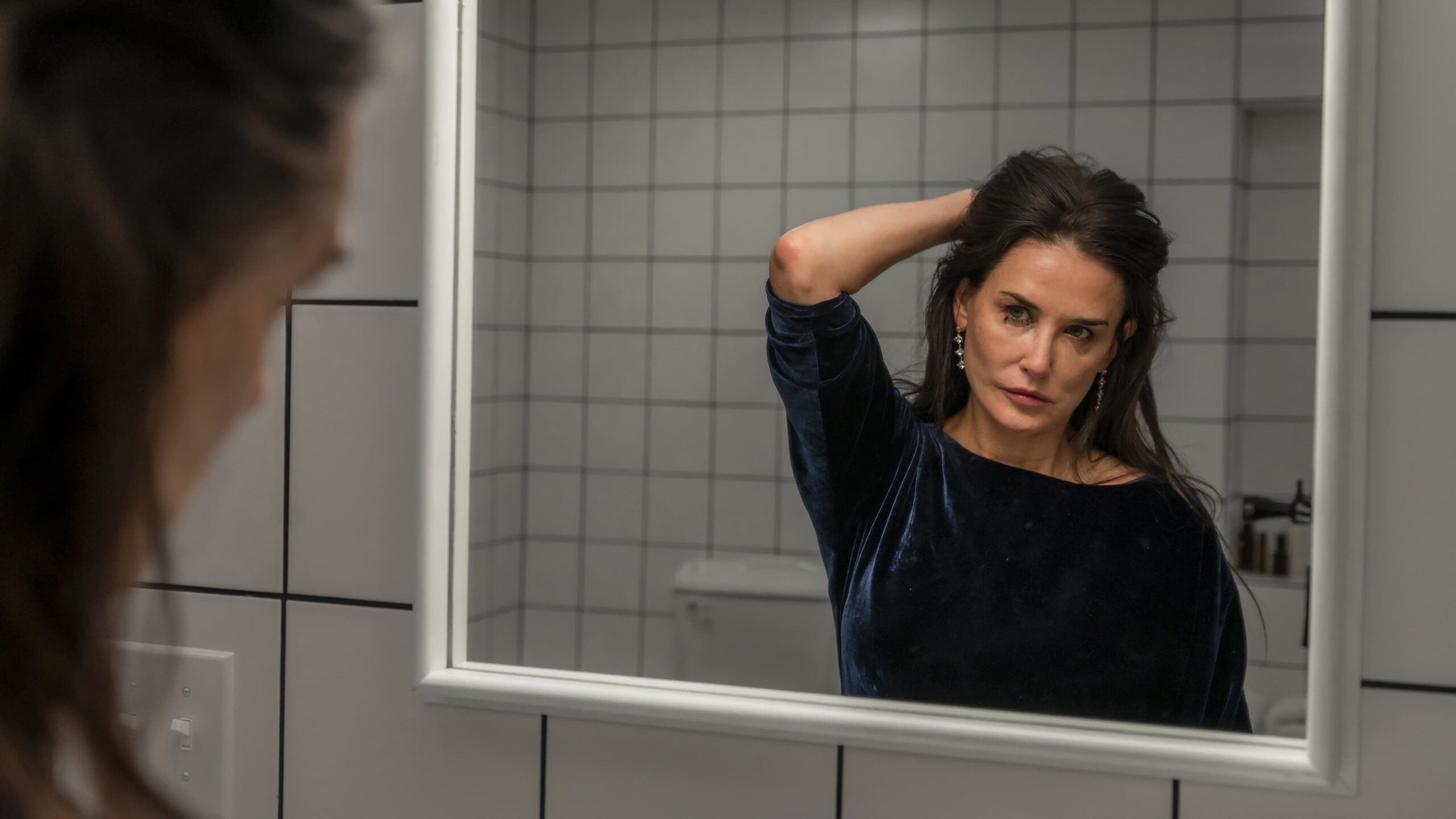Many of the most acclaimed bedtime fables are anything but subtle; and there’s a good reason for that. After all, the story in question exists as a means to deliver a moral or a value to its audience. The same can be said about cautionary sci-fi tales. Even many of the greatest genre movies around are beloved for anything but their subtlety. Of course, there’s nothing more exciting than a dense metaphor wrapped up into a story being told. But sometimes, as in the cases of the above genres mentioned, staking your claim with zero remorse and not beating around the bush is the best path forward. And it would appear that filmmaker Coralie Fargeat has no qualms with such an approach. Her last film, Revenge, was as brazen in its anger as it was in its depiction of extreme violence. The same can be said for her latest, The Substance, which throws Cinderella, Dr. Jekyll and Mr. Hyde, and a lifetime of splatter films into a blender, and then dumps a heap of modern beauty standards commentary on top of the whole creation. And once she serves that dish to you on a silver platter, you’ll be gobsmacked when trying to figure out exactly what it is you’re looking at. Still, you’ll be unable to turn away as it lures you in for seconds and thirds. And there’s few films this year that will delve into more exciting places than Fargeat’s.
If you’re beginning to sense that I’m being a bit on the nose about this film, it’s intentional. A film like The Substance is brash. It’s in your face. It has no intention of hiding its hand, perhaps with the exception of how far it’s willing to take its body horror and gnarly practical effects. If Fargeat was merely a filmmaker of style above all, cinema would be all the better for it. Lucky for us, she also has much loftier ambitions. Both Revenge and The Substance firmly plant themselves in the realm of genre films long past their prime. In the case of Revenge, it takes the contemporary form of a hyper-stylized exploitation film centered around revenge in the face of sexual assault. It’s a film that’s both lean and mean. The Substance leans far more into the realm of science-fiction, with its body-swapping tale of horrors. But for as horrific, upsetting, and downright saddening this film can be, it’s also a ton of fun. The reason? Fargeat understands how to craft a tone that audaciously keeps your audience enthralled. And it does so without losing any of the impact of her overarching ideas. If you wanted to get any sense of what type of film this would be, look no further than the introduction of Harvey (an absolutely bonkers Dennis Quaid). But before we meet him, we are introduced to Elisabeth Sparkle (Demi Moore) and her shining Hollywood star.

The above introduction is literal. Before we ever get eyes on Elisabeth, we come to understand where she is in her life. We see her star being set on the Hollywood Walk of Fame. It’s depicted with all the expected glamor that comes with such an achievement. We also see what inevitably happens over time. Like I wrote earlier, few things about this film are subtle, and the introduction doesn’t shy away from the obvious. Cracks begin to form and the excited photographs from fans slowly fade away. People outright make a mess on what many consider a testament to a legacy. It’s only after all this imagery of a faded star that we finally see Elisabeth face-to-face. And it’s ironic, yet clearly with complete intention, that for a film all about the idea of Hollywood aging women out from complex roles with substance to them, Moore as Elisabeth delivers an all-timer magnificent performance. It’s so acutely locked into everything Fargeat requires. For the film to work at all, both tonally and emotionally, Elisabeth must be completely understood. Moore’s performance is one of the few subtle elements to this film, and with good reason. As the viewer, we’re always clued into exactly why she’s making the decisions she’s making. Yet there’s a mystery to her. You never know the exact thoughts going on in her head, but the sentiment is felt fully. As we see Elisabeth performing a dance-exercise routine, you quickly get the sense that, to her, it’s become nothing more than a gig. And she’ll be damned if anybody, Harvey in particular, tries to take it from her. And lo and behold, Fargeat introduces Harvey to her audience with just that idea. This is not a kernel of a thought for him. He has his feet firmly planted in the notion that better ratings require a younger star.
It’s in this exact moment that The Substance bursts wide open with countless possibilities. The visual language of the film completely shifts. Its once-focused imagery shifts into something drastically raw. The camera seems mounted to the urinal, and in barrels Harvey, roaring right up to the camera as he unzips his pants. There’s movie star entrances aplenty for the eye to see in the history of film, but I’ve never quite seen such a monstrous introduction to a character. And that’s meant complimentary! Quaid’s abrasive performance is more than enough to pump any viewer full of electric energy and disgust, and it only gets more and more ridiculous as Fargeat begins to warp Elisabeth’s world. That being said, it’s not a stretch to say Fargeat is doing too much heavy lifting in terms of setting the table for her “inciting incident”. After all, misogyny in Hollywood is, unfortunately, anything but subtle. The mistreatment of those who don’t resemble the “ideal” or “perfection” are cast aside in the name of twisted outlooks on beauty standards and morals in general. For somebody like Harvey, he doesn’t think his words or actions will hurt anybody. Hell, he clearly thinks about nothing at all aside from the bottom line. In his mind, and almost certainly in the minds of many men, it’s just a fact of life. And this unfortunately extends far beyond Hollywood. But The Substance firmly roots itself in the problems plaguing Hollywood in particular. The reason? Likely because it all stems from the top. Movies and television are pushing the agenda of “ideal beauty standards”, and that in turn sets a dangerous precedent for any who consume it. It’s here that we reach Fargeat’s initial hook. Her fairy tale/sci-fi idea has presented Elisabeth with a questionable way out: Elisabeth has the special potion and Jack’s magic beans. Here is a more dangerous glass slipper with which to escape her current situation!

To avoid the larger details of where this film goes is difficult, but The Substance really excels in the smaller conundrums it presents its characters with beyond the initial premise of the film. For example, like any good sci-fi idea, Fargeat implants countless questions in the heads of her audience by merely exploring this dilemma further and further. It gets to the point of sheer lunacy through gross effects that only escalate the amount of squirms in the audience. It’s never desensitizing because, all in all, it is used sparingly. That is until the finale of course. Much like Revenge, The Substance also uses its extended finale to deliver quite the adrenaline-fueled sequence. Whereas her previous film ratchets up tension to its utmost potential, I’d say this film borders on revolting portrayal (and again, I mean this fully complimentary!) more than anything. That it was able to shock me so deeply despite two hours of build-up is a testament to the bold lengths Fargeat takes it. But that a single cut within the finale also caused the audience to burst
out with uproarious laughter is the immediate display of a filmmaker in complete control of her film, and in turn, her audience. The Substance, and especially the ending, is ridiculous in many ways. But it never loses any of its potency despite leaning so heavily into genre. In fact, it only makes Fargeat holding up a mirror to her audience and the industry that much more damning.
One of the most impressive elements about The Substance is just how well Fargeat is able to frame it. I don’t mean from a visual perspective, although the film does look gorgeous. I’m specifically referring to the ways in which Fargeat crafts the monster of her modern fairy tale. There’s countless sequences involving Sue (Margaret Qaulley) that would appear overindulgent in the hands of a lesser filmmaker. These sequences serve a distinct purpose here. Fargeat uses her camera in a way that mimics the leering eye of somebody like Harvey. Unlike Dr. Jekyll and Mr. Hyde, the “monstrous other half” in The Substance isn’t actually found in the body swapping other-half. It’s found in all the systems that force a set of circumstances onto a woman like Elisabeth. We see the internal struggle in Moore’s performance as she’s made to feel that her other-half is more of a necessity than anything else. And again, for as wildly as this film stretches its most extreme genre elements, it remains a consistently upsetting experience due to the reality that inspired it. If all the genre elements were to be stripped, this would be a gripping (and completely realistic) drama. At one point in the film, Sue is told she has “a pure heart” and “people are going to love that.” It’s a bold-faced proclamation about who the real monsters are, and just how willing they are to corrupt any semblance of real beauty. With The Substance, Fargeat confronts that corruption with anger, venom, and a whole lot of blood and gore.
The Substance releases in theaters on September 20, 2024.
